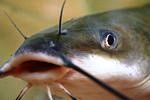The Senses and Defenses
A channel catfish's best adaptation against predators are its stinging spines. Anglers must be cautious of the three spines found on a channel catfish which can be found in the dorsal fin and on each of the pectoral fins. Many people say the sting is analogous to a severe paper cut. However, the stings can occasionally become infected and medical treatment is rarely needed. Since these spines can sting any organism that comes into contact with them, they are useful adaptations to defend against predators.
 Channel catfish use smell, sight and taste to find
food sources.
Channel catfish use smell, sight and taste to find
food sources.
Smell is the sensory organ that is most underdeveloped since the
catfish lives in an aqueous environment. The nostrils are
located on top of the catfish's mouth right below the eyes.
Sight can be used in clear waters to see food sources. Channel
catfish are able to use their sense of sight more since the eye
structure is larger than in other catfish species
Sight, even in clear waters, is not the most advanced sense.
Taste buds are located across the entire body of the channel catfish
with the barbels exhibiting the highest density.
Channel catfish are very resilient fish in that they can survive both harsh winters and summers. During the winter, channel catfish aggregate in deep pools and undergo semi-hibernation. During this time, catfish do not eat and instead lie dormant. To learn about what a catfish does eat, please see nutrition.
I bet you are wondering why the channel catfish would need these adaptations. To learn why, click on Habitat & Interactions!